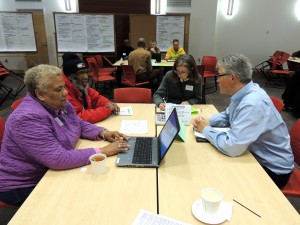With technology now providing online tools that show government expenditures in real time and make public budgets educational and interactive, citizens are coming to expect much more than a public meeting and a giant budget PDF posted to the website when it comes to budgeting visibility.
While these traditional methods remain a vital part of the budget cycle, there are new tools that promote not just financial transparency but also citizen engagement, such as Budget Simulator, Citizen Budget, Budget Allocator, and our very own Balancing Act. Online civic tech applications can make budget-related engagement more effective, efficient and authentic.
There are many budgets for citizens to consider. The 2012 Census of Governments found 89,005 public budgets in the United States ranging from the federal budget to municipalities to towns to special districts (fire, police, library, utility). Each of those entities will have different requirements for public input on the budget.
Here are five reasons to consider online tools to promote public engagement on those many and varied budget:
- Get more residents involved
Only one in four Americans have attended a local public meeting in the last year, according to a Governing article featuring data from the National Research Center. Often, those meetings lack a demographically broad representation of the community and can be dominated by the most vocal community members with a specific issue or an ax to grind.
Online engagement helps address this by lowering the transaction costs for civic-minded residents who can’t attend meetings because they might have to work or lack childcare. It also provides a place for input from those who don’t like public speaking or are turned off by partisanship. Online engagement tools also address the fact that most people would rather spend a few minutes submitting their feedback from the comfort of their own home rather than spend two hours in a stuffy meeting room to accomplish the same thing.

- Fast data collection and analysis
Without technology, there aren’t many options for effectively gathering and quickly evaluating citizen feedback on the budget. Using traditional methods of meetings and surveys, public officials must find ways to synthesize qualitative comments, spend money on a research group to conduct resident focus groups or mail out statistically significant polls. Online public engagement tools enable the collection of real-time data (both qualitative and quantitative) from community members, they are responsive to new developments (a simulation or forum topic can easily be updated), and their results often can be automatically analyzed.
- Promote transparency and interactivity of data
Public agencies have reams of data on everything from program budgets to parking violations, but none of it is very sexy. This data, however, often forms the basis of public sector decision-making. It also is a powerful indicator of public officials’ accountability with taxpayer money. It is true that all 50 states have passed some type of “sunshine law” promoting government openness, and most also have statutes that guarantee the public access to government documents and records. But even in this digital age, “public access” too often means scanned documents provided without context, perhaps living in a PDF graveyard on a little-accessed government webpage.
The new wave of civic technology makes this data more accessible for residents. Many online engagement tools build on and make this data more understandable, visual, and, especially, interactive. So, rather than simply showing residents a graph that represents financial data, new tools allow them to click on data segments and drill down for more details. Some tools also provide two-way interaction by giving citizens ways to provide structured feedback.
- Start your engagement earlier and more affordably
Public meetings are not cheap, largely due to the cost of staff members or outside consultants in preparing, implementing and evaluating them. It’s important to note that even the best forms of online engagement are no substitute for well-crafted and smartly publicized face-to-face meetings. But they are an effective complement. However, these web-based tools are usually quite affordable and allow public agencies to begin their outreach and engagement efforts far earlier. Take budget season: instead of going to the public with a series of meetings a month before the final budget must be approved, why not start 3-4 months earlier via an online engagement platform? This gives public officials more time to educate residents on each budget item, and gives residents more time to offer nuanced feedback.

- Test out different calls to action
One of the problems with face-to-face outreach is that public officials must craft one message for a varied audience, without much opportunity to test it out. A/B testing applications turn this problem on its head by easily allowing the creators of anything web-based to change the text on a certain page and test out different calls to action. Unsurprisingly, “Tell your local officials what really matters!” might elicit more engagement than “Comment box,” and these tools constantly run the analytics and optimize the page for what works best. Many also allow for A/B testing of various design and formatting features, meaning that after a few weeks, developers have a sense of what types of pages and widgets work best to attract meaningful feedback from different community members.
Creation of a budget is one of the most important tasks of government. At the same time, citizens need more ways to connect to the budgets that dictate where their tax dollars go.
If participation is the new transparency in government, then public entities need to use technology to reach more constituents, capture their input, and improve decision making for the greater good.




Leave a Reply
You must be logged in to post a comment.